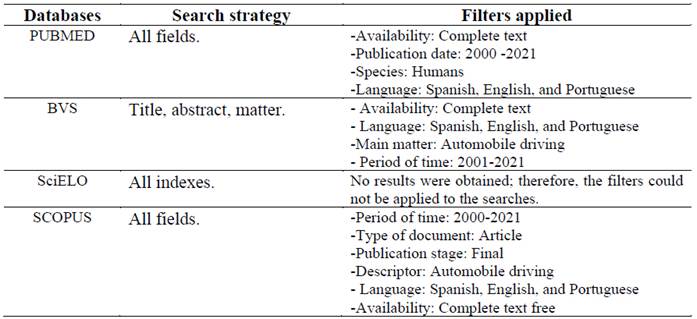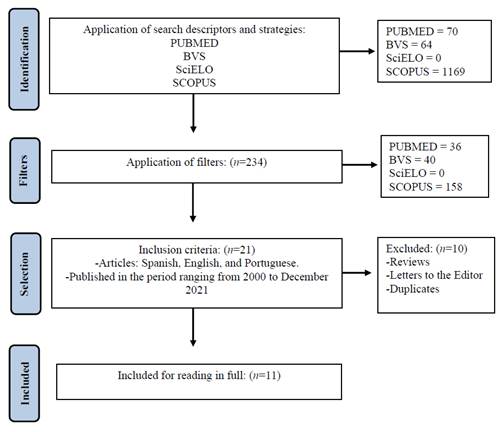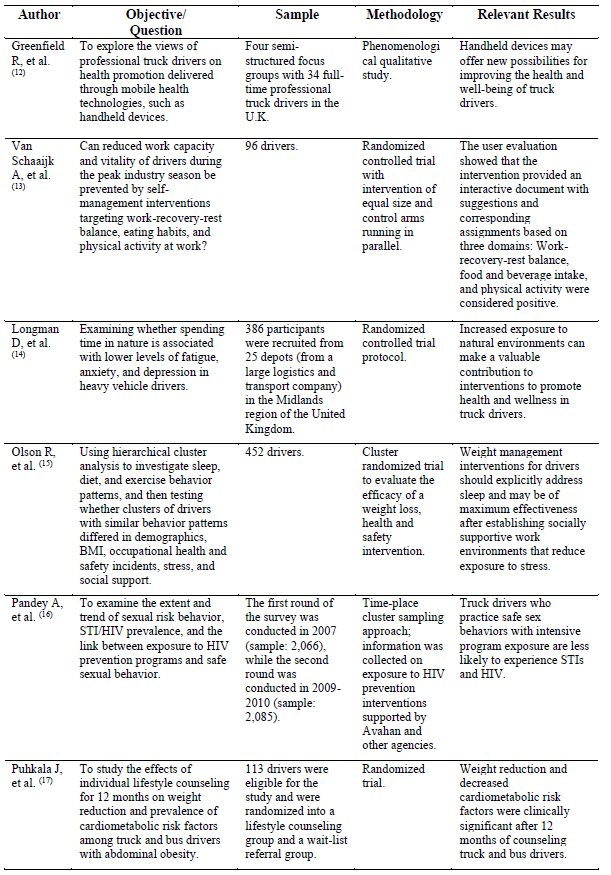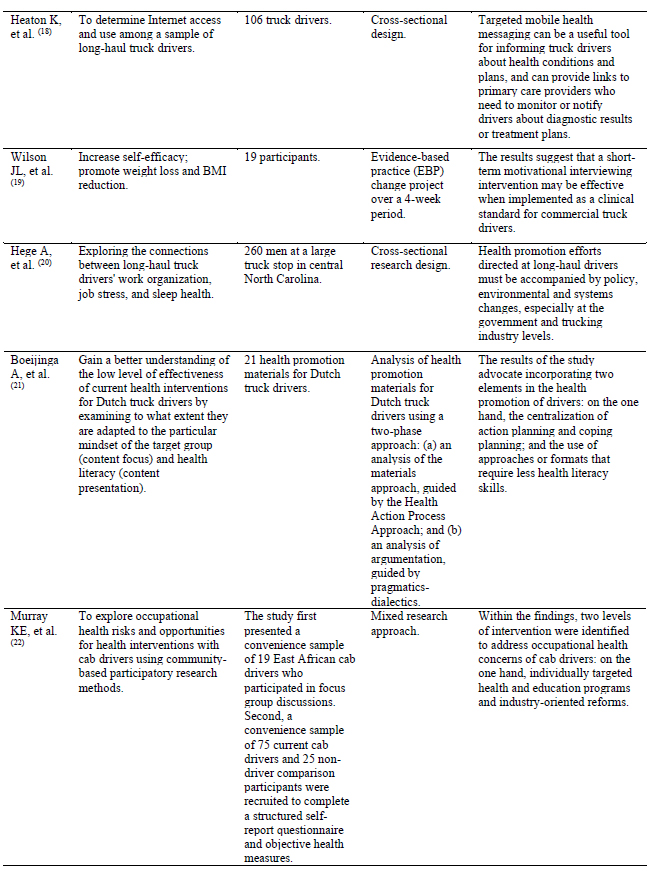Services on Demand
Journal
Article
Related links
Share
Enfermería: Cuidados Humanizados
Print version ISSN 1688-8375On-line version ISSN 2393-6606
Enfermería (Montevideo) vol.11 no.2 Montevideo Dec. 2022 Epub Dec 01, 2022
https://doi.org/10.22235/ech.v11i2.2849
Original articles
Systematic Review of Studies on Health-Promoting Interventions in Professional Drivers
1 Universidad de Antofagasta-Universidad Andrés Bello, Chile
2 Universidad de Concepción, Chile, svalenzu@udec.cl
3 Universidad de Concepción, Chile
4 Universidad de Concepción, Chile
5 Universidad de Concepción, Chile
Introduction:
Workers engaged in the driving field are exposed to factors that hinder their work tasks, such as: problems associated with temperature, noise and vibrations, insufficient and inefficient ventilation, traffic jams and interpersonal relationships with passengers.
Objective:
To identify, in the available state of the art, which interventions promote the health of professional drivers.
Method:
Systematic review, following the recommendations of the Preferred Reporting Items for Systematic Reviews and Meta-Analyses (PRISMA), guided by the question: what interventions promote the health of professional drivers?
Results:
The search yielded 1303 articles, of which 11 were included; the interventions identified were associated with handheld devices and mobile health messaging, motivational interviewing, interactive documents, exposure to natural environments, intensive programs, counseling, policy-level changes, environmental and systems changes.
Conclusion:
Interventions were identified that included technology, interviews, the environment and strategic control; the implementation of the identified interventions is recommended, since it is urgent to address the health of professional drivers, considering the characteristics described in this study.
Keywords: health promotion; automobile driving
Introducción:
Los trabajadores que se dedican al rubro de conducción están expuestos a factores que dificultan su quehacer laboral, tales como: problemas asociados a la temperatura, ruidos y vibraciones, ventilación insuficiente e ineficiente, atascos y relacionamientos interpersonales con los pasajeros.
Objetivo:
Identificar, en el estado del arte disponible, qué intervenciones promueven la salud de los conductores profesionales. Material y método: Revisión sistemática, siguiendo las recomendaciones de Preferred Reporting Items for Systematic reviews and Meta-Analyses (PRISMA), orientada por la pregunta: ¿qué intervenciones promueven la salud de los conductores profesionales?
Resultados:
La búsqueda arrojó 1303 artículos, de los cuales se incluyeron 11; las intervenciones identificadas se asociaron a dispositivos portátiles y mensajería de salud móvil, entrevistas motivacionales, documentos interactivos, exposición a entornos naturales, programas intensivos, asesoramiento, cambios a nivel de políticas, cambios ambientales y de sistemas.
Conclusión:
Se identificaron intervenciones que incluyeron a la tecnología, entrevistas, el ambiente y control estratégico. Se recomienda la implementación de las intervenciones identificadas, pues se torna perentorio el abordaje de la salud de los conductores profesionales, considerando las características descritas en el presente estudio.
Palabras clave: trabajo; promoción de la salud; conducción de automóvil.
Introdução:
Os trabalhadores envolvidos na condução estão expostos a fatores que dificultam o seu trabalho, tais como: problemas associados à temperatura, ruído e vibrações, ventilação insuficiente e ineficiente, engarrafamentos e relações interpessoais com os passageiros. Objetivo: Identificar, a partir do estado da arte disponível, quais as intervenções que promovem a saúde dos condutores profissionais.
Método:
Revisão sistemática, seguindo as recomendações dos itens Preferred Reporting Items for Systematic Reviews e Meta-Analyses (PRISMA), orientada pela pergunta: Quais intervenções promovem a saúde dos condutores profissionais?
Resultados:
A pesquisa produziu 1303 artigos, dos quais 11 foram incluídos; as intervenções identificadas foram associadas a dispositivos portáteis e mensagens de saúde móveis, entrevistas motivacionais, documentos interativos, exposição a ambientes naturais, programas intensivos, aconselhamento, mudanças a nível político, mudanças ambientais e de sistemas.
Conclusão:
Foram identificadas intervenções que incluíram tecnologia, entrevistas, ambiente e controle estratégico; recomenda-se a implementação das intervenções identificadas, pois é imperativo abordar a saúde dos condutores profissionais, considerando as características descritas no presente estudo.
Palavras-chave: promoção da saúde; condução de automóvel
Introduction
According to the World Health Organization (WHO), all workers are exposed to risks in their workplace, ranging from biological, chemical, physical, and ergonomic factors, as well as accidents and psychosocial risks. 1) These risks can be present in all Works, distributed in different measures, depending on, among other things, job characteristics, position, and work environment. In the case of workers who are dedicated to driving, problems associated to temperature, noise, and vibration, insufficient and inefficient ventilation, traffic jams and interpersonal relationships with passengers. 2
Other items that have been identified as risks in professional drivers are those of psychosocial type, 3) which in turn seem to have a negative relationship with the quality of life of such group, preventing the efficient performance of their work, and even associating it to an increase of the likelihood of causing traffic accidents. In addition to the foregoing, it has been mentioned 4) a constant fear on the part of professional drivers of being assaulted or involved in an accident; additionally, this group has been negatively associated to alcohol consumption and poor eating habits, culminating in chronic non-communicable diseases, for example, high blood pressure, which is present in more than one third of drivers worldwide, exceeding the general population. 5
In view of the above, this is particularly relevant when the International Labor Organization (ILO) states that the road transport sector is of fundamental strategic importance for social and economic development. In addition, it ensures the mobility of passengers and goods between territories and countries, thus contributing greatly to economic growth and job creation. (6) However, evidence indicates that public transport drivers present, in general and at a global level, unfavorable working conditions, with the presence of physical and psychological risks. 7) In the case of truck drivers, not only do they face fatalities and injuries caused by vehicle collisions, but compared to other workers, they are exposed to greater risks of occupational illnesses and accidents. (8
One health challenge is to support these workers by reinforcing healthier lifestyles and promoting their personal health through actions aimed at maintaining physical, mental, and social well-being in the workplace. In 2012, workplace health promotion was defined by the ILO as “the joint effort of employers, workers, and society to improve the health and well-being of people in the workplace.” (9) This has been considered as a strategy that not only involves providing education, but also counseling and motivation for behavioral change.
Currently, health promotion in the workplace is addressed only to a limited extent, since few attempts have been made to apply it, which would allow professional drivers, in this case, to increase their control over their health to improve it and positively influence their working conditions. 10 In view of the above, considering the importance of professional drivers, the risks to which they are exposed, and the need to promote the health of this population, the present research was developed with the objective of identifying interventions, in the available state of the art, that promote the health of professional drivers.
Materials and method
Systematic review type research, whose guiding question was: What interventions promote the health of professional drivers? To carry out the review, it was structured based on the Preferred Reporting Items for Systematic Reviews and Meta-Analyses (PRISMA) statement updated in 2020. 11) Having circumscribed the research problem, the searches were then organized in Spanish, English and Portuguese, using the MeSH and Boolean descriptors shown in Table 1.
The searches performed considered articles up to December 2021, including the following databases: PUBMED (United States National Library of Medicine), SCOPUS, SciELO (Scientific Electronic Library Online), and BVS (Biblioteca Virtual en Salud). The search strategies and filters used in each database are shown in Table 2.
The inclusion criteria used considered articles in the three languages mentioned (Spanish, English, and Portuguese), documents published in the period ranging from 2000 to 2021 (up to December), and related to professional drivers; the exclusion criteria corresponded to reviews, letters to the editor and duplicity of manuscripts; first of all, the titles and abstracts of the articles located were reviewed, and those that met the exclusion criteria were read in full. Figure 1 shows the review flowchart.
After the application of descriptors and search strategies, a total of 1303 articles were identified; after the application of filters, 234 articles were located; after the application of the inclusion criteria, 21 articles remained; and finally, after the application of the exclusion criteria, 11 articles remained.
Results
To complete the review process, the most relevant results of the selected articles will be presented and interpreted. Valuable contributions were highlighted, which can be grouped into 5 dimensions: technology, counseling and motivational interviewing, environmental control, sexual health, and strategic approach. Table 3 P1 summarizes these articles according to author, objective or question, sample, methodology and relevant results.
Discussion
In terms of technology, portable devices were described as new possibilities for improving the health and well-being of drivers; 12) consistent with what has been described associated with targeted mobile health messaging, 18 since these are useful tools for informing professional drivers about health conditions and plans, and have also been shown to contribute to primary care, especially for monitoring or reporting diagnosis results or treatment plans. This is of particular importance in the nutritional alterations due to excess in drivers, as described by the scientific community. 10
The above is consistent with the findings of Hafidy, et al, 23 who identified 220 mobile applications that can help improve driving behavior; however, the findings of Barengo NC, et al, 24 have reported inconsistent results on whether mobile health technologies are effective in reducing HbA1C levels or the incidence of type 2 diabetes in patients with prediabetes, but may hold promise for decreasing body weight.
In relation to motivational counseling and interviewing, the intervention associated with providing an interactive document with suggestions in the area of work-recovery-rest balance, food and beverage intake, and physical activity was positively assessed. 13) In addition to the above, after 12 months of counseling with professional drivers, there was evidence of a reduction in weight and a decrease in significant cardiometabolic risk factors. 17 Additionally, it has been described that short-term motivational interviewing can be effective when implemented as a clinical standard for professional drivers. 19 It has been recommended to consider those approaches or formats that require less health literacy skills, 21 as well as an individual approach. 22
This is consistent with another review, which notes that interventions that include a combination of training and other resources can provide successful weight reduction for truck drivers and are of clinical importance in guiding the development of future interventions in this industry. (25 This takes on particular importance, since noncommunicable diseases among drivers, for example, of buses, have been described as a growing threat, generating a substantial burden on the health system and services. 26
In terms of environmental control, an exposure to environmental settings with nature can contribute to health and wellness promotion interventions. 14) This is consistent with another study, where it is noted that sleep should be explicitly addressed in weight management interventions, where benefits can be obtained as maximum efficacy after establishing socially supportive work environments that reduce exposure to stress. 15
In the sexual health dimension, a study that is included describes that exposure to an intensive program in professional drivers who practice safe sexual behaviors was less likely to suffer sexually transmitted infections and HIV. 16) This is particularly important because HIV-positive drivers with associated neurocognitive impairment have been reported to be at increased risk of poor driving performance in a simulation test. 27
Finally, in the dimension of the strategic approach, it is recommended that health promotion in professional drivers should include changes at the policy, environment and systems levels, especially at the governmental level. 20 Another study adds centralization in action planning and coping planning, 21) and industry-oriented reforms; 22) as such considerations at the strategic level will enable a culture of health promotion to be established in the target community.
It is highlighted as a challenge to continue building knowledge associated with health promotion interventions in professional drivers. Although several results were identified, there are problems not covered by the interventions identified, such as those related to musculoskeletal pain. In that line, a high prevalence has been seen in professional drivers, being the lumbar area reported in the study of Joseph L, et al, 28 as the most affected, whose risk factors can be mitigated through stretching programs, together with road safety education. 29
The limitations of the present study are limited to the databases consulted and, consequently, to the sample identified. In addition, in terms of strengths, the present review is the first known to provide a variety of interventions including different levels of health management, from health care and environmental aspects to strategic approaches. Moreover, the findings identified may complement other reviews that have not identified specific occupational interventions targeted at older HGV drivers in the categories of health, safety, well-being, and other occupational factors, 30 and may provide new insights that have not been considered.
As considerations for future studies, it is recommended to generate new interventions associated with the identified gaps and their consideration in professional drivers.
Conclusions
The present study was able to respond to the objective of identifying, in the available state of the art, which interventions promote the health of professional drivers. Several interventions were identified, which were grouped into 5 dimensions: technology, counseling and motivational interviewing, environmental control, sexual health and strategic approach. It is recommended that these interventions be considered by the health area, as this approach is essential for professional drivers.
There is important evidence of the positive effect of health promotion programs in workplaces. The study subjects vary according to the objectives of the researchers, with a scarce scientific production in professional bus drivers. There is a challenge in the permanence and adherence of the study subjects to perform or integrate the interventions.
REFERENCES
1. Organización Mundial de la Salud. El número de accidentes y enfermedades relacionados con el trabajo sigue aumentando (Internet). Ginebra: OMS; 2005 (citado 15 Nov 2021). Disponible en: Disponible en: https://apps.who.int/mediacentre/news/releases/2005/pr18/es/index.html [ Links ]
2. Aquino JM, Gomes de Medeiros SE, Ribeiro Gomes BM, Ferreira e Pereira EB, Brandão Neto W, Gomes Terra M. Condiciones de trabajo en conductores de autobús: de servicio público a fuente de riesgo. Index Enferm (Internet). 2017;26(1-2):34-38. Disponible en: http://scielo.isciii.es/scielo.php?script=sci_arttext&pid=S1132-12962017000100008&lng=es. [ Links ]
3. Bonilla-Rueda L, Gafaro-Rojas A. Condiciones laborales y riesgos psicosociales en conductores de transporte público. Revista Cubana de Salud y Trabajo (Internet). 2020;18(2):48-56. Disponible en: http://revsaludtrabajo.sld.cu/index.php/revsyt/article/view/31 [ Links ]
4. Sepúlveda Guerra EB, Valenzuela Suazo SV, Rodríguez Campo VA. Condiciones laborales, salud y calidad de vida en conductores. Rev Cuid (Internet). 2020;11(2):e1083. DOI: 10.15649/cuidarte.1083 [ Links ]
5. Krishnamoorthy Y, Sarveswaran G, Sakthivel M. Prevalence of hypertension among professional drivers: Evidence from 2000 to 2017. A systematic review and meta-analysis. J Postgrad Med (Internet). 2020;66(2):81. DOI: 10.4103/jpgm.JPGM_297_19 [ Links ]
6. Organización Internacional del Trabajo. Directrices sobre la promoción del trabajo decente y la seguridad vial en el sector del transporte. Ginebra: OIT; 2020. [ Links ]
7. Arias-Meléndez C, Comte-González P, Donoso-Núñez A, Gómez-Castro G, Luengo-Martínez C, Morales-Ojeda I. Condiciones de trabajo y estado de salud en conductores de transporte público: una revisión sistemática. Med Segur Trab (Madr) (Internet). 2022;67(265):278-97. DOI: 10.4321/s0465-546x2021000400004 [ Links ]
8. Berrones Sanz LD, Cano Olivos P, Sánchez Partida D, Martínez Flores JL. Lesiones, enfermedades y accidentes de trabajo de los conductores del autotransporte de carga en México. Acta Univ (Internet). 2018;28(3):47-55. DOI: 10.15174/au.2018.1946 [ Links ]
9. Organización Internacional del Trabajo. Promoción de la salud y el bienestar en el trabajo (internet). Suiza: OIT; 2012. Disponible en: http://www.ilo.org/safework/areasofwork/workplace-health-promotion-and-well-being/lang--es/index.htm . 2012. [ Links ]
10. Nail Gallardo VA, Ríos Ojeda CA, Fernández Silva C. Conductas promotoras de salud en alimentación saludable y actividad física en conductores de la locomoción colectiva de una empresa privada de la ciudad de Puerto Montt, Chile. Rev Iberoam Educa Investi Enferm 2016;6(4):33-40. Disponible en: https://www.enfermeria21.com/revistas/aladefe/articulo/220/conductas-promotoras-de-salud-en-alimentacion-saludable-y-actividad-fisica-en-conductores-de-la-locomocion-colectiva-de-una-empresa-privada-de-la-ciudad-de-puerto-montt-chile/ [ Links ]
11. Page MJ, McKenzie JE, Bossuyt PM, Boutron I, Hoffmann TC, Mulrow CD, et al. Declaración PRISMA 2020: una guía actualizada para la publicación de revisiones sistemáticas. Rev Española Cardiol (Internet). 2021;74(9):790-9. DOI: 10.1016/j.recesp.2021.06.016 [ Links ]
12. Greenfield R, Busink E, Wong CP, Riboli-Sasco E, Greenfield G, Majeed A, et al. Truck drivers' perceptions on wearable devices and health promotion: a qualitative study. BMC Public Health. 2016;16(1):1-10. DOI: 10.1186/s12889-016-3323-3 [ Links ]
13. Schaaijk AV, Nieuwenhuijsen K, Frings-Dresen M. Work Ability and Vitality in Coach Drivers: An RCT to Study the Effectiveness of a Self-Management Intervention during the Peak Season. Int J Environ Res Public Health. 2019;16(12):1-17. DOI: 10.3390/ijerph16122214 [ Links ]
14. Longman D, Shaw C, Varela-Mato V, Sherry A, Ruettger K, Sayyah M, et al. Time in Nature Associated with Decreased Fatigue in UK Truck Drivers. International Journal of Environmental Research and Public Health. 2021;18(6):1-17. DOI: 10.3390/ijerph18063158 [ Links ]
15. Olson R, Thompson SV, Wipfli B, Hanson G, Elliot DL, Anger WK, et al. Sleep, Dietary, and Exercise Behavioral Clusters Among Truck Drivers with Obesity. Journal of Occupational and Environmental Medicine. 2016;58(3):314-321. DOI: 10.1097/JOM.0000000000000650 [ Links ]
16. Pandey A, Mishra R, Sahu D, Benara S, Sengupta U, Paranjape R et al. Heading towards the Safer Highways: an assessment of the Avahan prevention programme among long distance truck drivers in India. BMC Public Health. 2011;11(6):1-12. DOI: 10.1186/1471-2458-11-S6-S15 [ Links ]
17. Puhkala J, Kukkonen-Harjula K, Mansikkamäki K, Aittasalo M, Hublin C, Kärmeniemi P, et al. Lifestyle counseling to reduce body weight and cardiometabolic risk factors among truck and bus drivers a randomized controlled trial. Scand J Work Environ Health. 2015;41(1):54-64. DOI: 10.5271/sjweh.3463 [ Links ]
18. Heaton K, Combs B, Griffin R. Truck Drivers Use of the Internet: A Mobile Health Lifeline. Workplace Health & Safety. 2017;41(6):240-247. DOI: 10.1177%2F2165079916665401 [ Links ]
19. Wilson JL, Wolf DM, Olszewski KA. Reducing Commercial Truck Driver BMI Through Motivational Interviewing and Self-Efficacy. Workplace Health & Safety. 2018;66(6):270-275. DOI: 10.1177%2F2165079918754585 [ Links ]
20. Hege A, Lemke MK, Apostolopoulos Y, Sönmez S. The Impact of Work Organization, Job Stress, and Sleep on the Health Behaviors and Outcomes of U.S. Long-Haul Truck Drivers. Health Education & Behavior. 2019;46(4):124-140. DOI: 10.1177%2F1090198119826232 [ Links ]
21. Boeijinga A, Hoeken H, Sanders J. An analysis of health promotion materials for Dutch truck drivers: Off target and too complex? Work. 2017;56(4):539-549. DOI: 10.3233/WOR-172503 [ Links ]
22. Murray KE, Abdimalik B, Rasheed A, Cavanaugh AM, Kidane L, Hussein M, et al. Occupational health risks and intervention strategies for US taxi drivers. Health Promotion International. 2019;34(2):323-332. DOI: 10.1093/heapro/dax082 [ Links ]
23. El hafidy A, Rachad T, Idri A, Zellou A. Gamified Mobile Applications for Improving Driving Behavior: A Systematic Mapping Study. Mob Inf Syst (Internet). 2021;2021:1-24. DOI: 10.1155/2021/6677075 [ Links ]
24. Barengo NC, Diaz Valencia PA, Apolina LM, Estrada Cruz NA, Fernández Garate JE, Correa González RA, et al. Mobile Health Technology in the Primary Prevention of Type 2 Diabetes: a Systematic Review. Curr Diab Rep (Internet). 2022 Jan 3;22(1):1-10. DOI: 10.1007/s11892-021-01445-w [ Links ]
25. Pritchard EK, Kim HC, Nguyen N, van Vreden C, Xia T, Iles R. The effect of weight loss interventions in truck drivers: Systematic review. Wieland LS, editor. PLoS One (Internet). 2022;17(2):e0262893. DOI: 10.1371/journal.pone.0262893 [ Links ]
26. Arun R, Stanly AM. A Review of Risk Factors for Non-Communicable Diseases Among Bus Drivers. Natl J Community Med (Internet). 2022;13(06):404-10. DOI: 10.55489/njcm.130620222034 [ Links ]
27. Gouse H, Masson CJ, Henry M, Thomas KGF, Robbins RN, Kew G, et al. The Impact of HIV-Associated Neurocognitive Impairment on Driving Performance in Commercial Truck Drivers. AIDS Behav (Internet). 2021;25(3):689-98. DOI: 10.1007/s10461-020-03033-7 [ Links ]
28. Joseph L, Standen M, Paungmali A, Kuisma R, Sitilertpisan P, Pirunsan U. Prevalence of musculoskeletal pain among professional drivers: A systematic review. J Occup Health (Internet). 2020;62(1). DOI: 10.1002/1348-9585.12150 [ Links ]
29. Pickard O, Burton P, Yamada H, Schram B, Canetti EFD, Orr R. Musculoskeletal Disorders Associated with Occupational Driving: A Systematic Review Spanning 2006-2021. Int J Environ Res Public Health (Internet). 2022;19(11):6837. DOI: 10.3390/ijerph19116837 [ Links ]
30. Batson A, Newnam S, Koppel S. Health, safety, and wellbeing interventions in the workplace, and how they may assist ageing heavy vehicle drivers: A meta review. Saf Sci (Internet). 2022;150:105676. DOI: 10.1016/j.ssci.2022.105676 [ Links ]
How to cite: Valencia-Contrera MA, Valenzuela-Suazo SV, Rodríguez-Campo VA, Jara-Concha PDT, Sepúlveda-Guerra EB. Systematic review of studies on health-promoting interventions in professional drivers. Enfermería: Cuidados Humanizados. 2022;11(2):e2849. DOI: 10.22235/ech.v11i2.2849
Authors’ participation: a) Conception and design of the work; b) Data acquisition; c) Analysis and interpretation of data; d) Writing of the manuscript; e) Critical review of the manuscript. M. A. V. C. has contributed in a, b, c; S. V. V. S. in a, b, c; V. A. R. C. in c, d, e; P. D. T. J. C. in c, d, e; E. B. S. G. in c, d, e.
Received: February 10, 2022; Accepted: September 13, 2022











 text in
text in 








